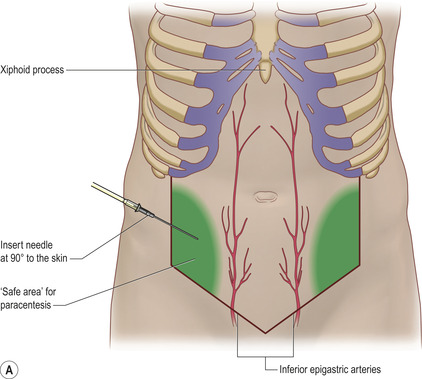CHAPTER 16. ABDOMINAL PARACENTESIS AND ASCITIC DRAIN INSERTION
Ascitic drain insertion134
Post-procedure care and investigations139
Complications140
Suggested reading140
Hippocrates (460–377 BC) was known to have utilized abdominal paracentesis for the treatment of ascites. Accumulated abdominal fluid was frequently the endpoint of congestive cardiac failure. One of the earliest treatments for fluid accumulation (hydropsy or dropsy) involved use of fine percutaneous tubes to cause seepage of interstitial fluid. These famous Herbert Southey’s (1783–1865) silver tubes were used for any oedematous part of the body. A natural extension of such therapy was abdominal paracentesis. Ludwig van Beethoven (1770–1827) underwent repeated paracentesis for ascites related to cirrhosis (undiagnosed at the time). Historians have recently blamed Beethoven’s doctor for contributing to his death by lead poisoning due to the poultices applied to the paracentesis sites!
ABDOMINAL PARACENTESIS
INTRODUCTION
Abdominal paracentesis is performed as a supplementary diagnostic procedure to determine the cause of ascites or new abdominal pain in patients with ascites. In cirrhotic patients it is commonly performed when there is a suspicion that new symptomatology is due to spontaneous bacterial peritonitis or malignancy. Coagulopathies are not contraindications to the procedure given a large number of patients with ascites of hepatic origin will have abnormal clotting. Ascitic paracentesis has been outlined below in accordance with the British Society of Gastroenterology guidelines.
INDICATIONS
• Diagnostic investigations of abdominal ascites.
CONTRAINDICATIONS
• Local infection overlying the puncture site.
• Highly deranged coagulopathy.
• Lack of consent.
EQUIPMENT
• Dressing pack.
• Sterile gloves.
• Orange needle.
• Green needle × 2.
• 20 mL syringe.
• 10 mL syringe.
• Lidocaine.
• Gauze.
• Chlorhexidine cleaning solution.
• Sterile drapes.
• Plaster.
• Skin pen.
• Blood culture bottles.
• Blood glucose tube–fluoride oxalate tube.
• EDTA tube.
• Sterile bottles × 2.
PRACTICAL PROCEDURE
• Explain the procedure to the patient and gain consent.
• If ascites is not distending the abdomen it is prudent to undertake ultrasound examination to locate the fluid.
 Tip Box
Tip BoxEnsure the patient has an empty bladder prior to the procedure.
• Raise the level of the bed until their abdomen is at a comfortable height for you to perform the procedure.
• Palpate and percuss the edge of the liver to ensure you know its position.
• Percuss the ascites by assessing for shifting dullness: percuss the abdomen in the supine position listening for the transition point between resonance and dullness. The central abdomen should be resonant and the flanks dulled by the presence of dependent ascites. Ask the patient to then roll into the lateral position and wait approximately 5 seconds. Percuss over the area that was previously dull: if this now sounds resonant, this is indicative of shifting dullness.
• A spot lateral to this in the right or left lower quadrant can be marked but should be in the safe area (Fig. 16.1 A and B). The commonest site for an ascitic tap is about 15 cm lateral to the umbilicus in the left or right lower quadrant. The aim is to avoid solid structures such as liver and spleen in the upper abdomen and the lower epigastric arteries and bowel in the lower abdomen.
 Tip Box
Tip BoxAvoid areas with superficial dilated veins, especially in the presence of portal hypertension.
• Wash your hands and wear sterile gloves.
• Clean the area and place the sterile drapes.
• Draw up the lidocaine in a 10 mL syringe and attach the orange needle.
• Warn the patient of a sharp scratch and infiltrate 2 mL of the local anaesthetic subcutaneously over the marked area using an orange needle.
• Check the area is adequately anaesthetized with gentle poking of the skin with the needle.
• Infiltrate local anaesthetic into deeper tissues advancing the green needle obliquely until ascitic fluid is aspirated.
 Tip Box
Tip BoxThis oblique direction is termed the ‘Z track’, ensuring the sites of needle entry at the skin and at the peritoneum do not overlie one another. This reduces the risk of continuing leak from the puncture site following the procedure.
• Assemble the 20 mL syringe and green needle.
• Once the required volume of the sample has been obtained, withdraw the needle and place firm pressure on the area with some gauze.
• Apply a sterile dressing.
• Inoculate ascitic fluid into blood culture bottles, specimen bottles, a fluoride-oxalate tube and an EDTA tube.
• Document the procedure clearly in the patient’s medical notes. Note the macroscopic appearance of the fluid (e.g. straw-coloured, turbid, haemorrhagic).
• Advise the patient to lie on the opposite side to paracentesis for approximately 2 hours should any ascites leak from the site of aspiration.
Stay updated, free articles. Join our Telegram channel

Full access? Get Clinical Tree




